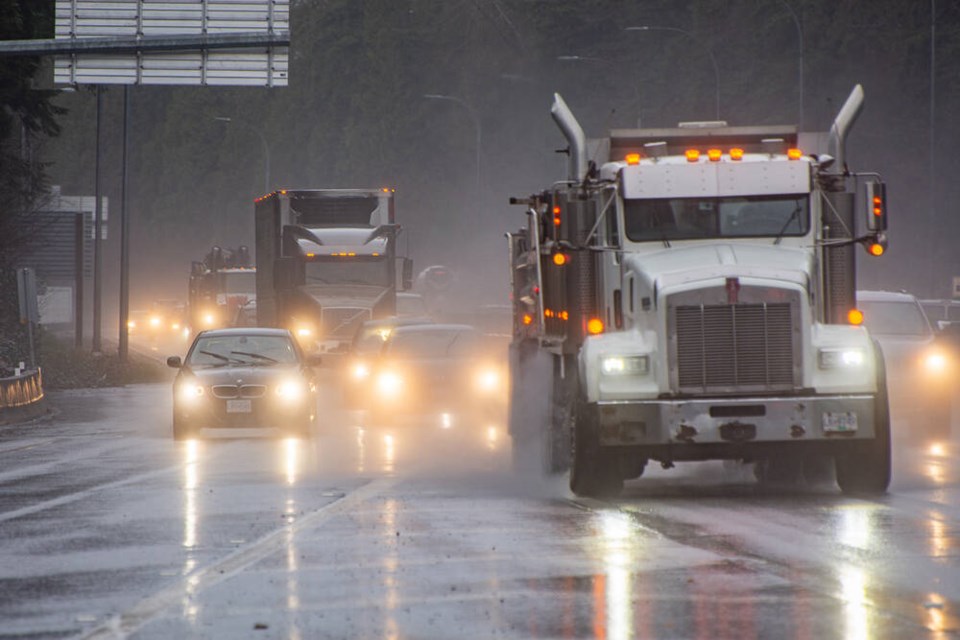If it looks like road markings are performing a disappearing act in dark or wet weather, you’re not the only one experiencing this unintended magic trick.
District of North Vancouver staff will explore options to improve paint and other devices meant to provide cues to drivers on roadways, after a unanimous vote by council on April 8.
As many of the roads passing through the district are the responsibility of the Ministry of Transportation and Infrastructure, staff will also work to prepare a letter expressing council’s concerns to the provincial government.
Mayor Mike Little prefaced the discussion stating that the window to put any new improvements into place has passed for this year.
“There are some things they can do – get some information going and maybe trial a few different options this year – but the annual maintenance for this period has already started and has already contracted and tendered,” he said.
As for the ways roads are currently marked in the district, staff can do a better job, said Gavin Joyce, general manager of engineering, parks and facilities.
The two primary materials used are thermoplastic and paints, including a more environmentally friendly “waterborne” paint used in recent years, Joyce said.
“That doesn’t last very long, a year or two at the most,” he said. “Thermoplastic lasts considerably longer.”
Staff are looking at other products like a special 3M paint called “wet night,” which is set to be used on East Keith Road, Joyce said. But it’s “incredibly expensive,” he added, and so staff will come back with more detailed research on what options could be a good fit.
He also noted that many of the grievances staff receive are for roads outside the district’s control.
“About 80 per cent of the complaints we do get around infrastructure [are for roads] looked after by the ministry,” Joyce said, suggesting council endorse the letter to the province.
'The white paint is just absolutely disappearing'
Coun. Lisa Muri said much of the problem arises from the federal government prohibiting oil-based paint, which has forced a move to water-based options.
“I know we’ve all experienced this, and I think the one that was the most telling was right after we finished the Mountain Highway Interchange,” she said. “I phoned Mr. Joyce and I said, ‘All the lines on the road have disappeared.’ And he went down the route on his way home after a council meeting. And lo and behold, all the lines have disappeared.”
In some cases the road markings are chipping off, and in other cases it’s fading, Muri said, adding that yellow lines painted by MOTI are holding up better.
“The white paint is just absolutely disappearing,” she said.
But the problem extends beyond paint, Muri said. During an annual cleanup on Mount Seymour Parkway, volunteers pick up dozens of the reflective road markers called “cat’s eyes,” which have been chipped off the asphalt by snow plows, the councillor explained.
Muri said she fears for drivers who are nervous driving in low light.
“It’s frightening," she said "And if you’re not very clear on where you should be on the road, and you’re relying on those lines, they’re just not there to help protect you."
Coun. Jordan Back said he would be happy to see more resources go to road safety in general.
“Specific to road markings, I’m not sure if this is going to make a huge difference in terms of road safety for the potential cost,” he said.
While it’s important to improve road safety for all road users, Back said he always considers the most vulnerable users, like pedestrians and cyclists, first.
The district should be talking to both ICBC and the province, and prioritizing areas where more accidents are being recorded, said Mayor Mike Little.
“Maybe we do push it to a higher standard, even if it has a higher cost, in areas that are within our jurisdiction and represent a higher aggregate crash statistic,” he said.
The mayor also questioned the intensity of the white street lights that have been installed in recent years.
“I don’t know if they’re helping,” he said. “I think they’re helping me see cars in detail, and they’re definitely helping me see pedestrians better. But I gotta say, the yellow lines pop, the white lines disappear.”




